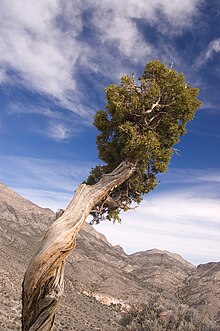Juniperus osteosperma
| Utah juniper | |
|---|---|

| |
| A Utah juniper showing distinctive shape and leaves | |
| Scientific classification | |
| Kingdom: | Plantae |
| Clade: | Tracheophytes |
| Clade: | Gymnospermae |
| Division: | Pinophyta |
| Class: | Pinopsida |
| Order: | Cupressales
|
| Family: | Cupressaceae |
| Genus: | Juniperus |
| Species: | J. osteosperma
|
| Binomial name | |
| Juniperus osteosperma | |

| |
| Natural range | |
Juniperus osteosperma (Utah juniper; syn. J. utahensis) is a shrub or small tree native to the southwestern United States.
Description
The plant reaches 3–6 meters (9 ft 10 in – 19 ft 8 in), rarely to 9 m, tall. The shoots[
The plants frequently bear numerous galls caused by the juniper tip midge Oligotrophus betheli (Bibionomorpha: Cecidomyiidae); these are conspicuous pale violet-purple, produced in clusters of 5–20 together, each gall 1–2 centimetres (3⁄8–3⁄4 in) in diameter, with dense modified spreading scale-leaves 6–10 mm (1⁄4–3⁄8 in) long and 2–3 mm broad at the base.
-
J. osteosperma leaves, female and male cones
-
Utah Juniper galls
-
Seedling in northeastern Nevada
Distribution and habitat
The species is native to the southwestern
Ecology
Seeds are dispersed by a variety of mammals and birds. Mammals include
Uses
Native Americans such as the Havasupai used the bark for a variety of purposes, including beds, and ate the cones both fresh and in cakes.[6] The Havasupai used the gum to make a protective covering over wounds. Additionally, the Yavapai gave their women a tea made from the leaves to calm their contractions after giving birth, and fumigated them with smoke from the leaves placed over hot coals. The Navajo sweep their tracks with boughs from the trees so death will not follow them.[7]
A small quantity of ripe berries can be eaten as an emergency food or as a sage-like seasoning for meat. The dried berries can be roasted and ground into a coffee substitute.[8]
Utah juniper is an aromatic plant. Essential oil extracted from the trunk and limb is prominent in α-pinene, δ-3-carene, and cis-thujopsene. Essential oil extracted from the leaf is prominent in camphor and bornyl acetate.[9] The trunk of Utah juniper retains essential oil for at least 20 years after the tree dies, and is prominent in cedrol and cis-thujopsene.[10]
See also
- Pinyon-juniper woodland
References
- . Retrieved 11 November 2021.
- OCLC 1141235469.
- ISBN 0394507614.
- S2CID 38377131.
- JSTOR 2425289.
- ISBN 0-394-73127-1.
- Bonanza Books. pp. 265–66.
- OCLC 244766414.
- ^ Wilson TM, Poulson A, Packer C, Marshall J, Carlson RE, Buch RM. "Essential oils of whole tree, trunk, limbs and leaves of Juniperus osteosperma from Utah". Phytologia. 101 (3): 188–193.
{{cite journal}}: CS1 maint: multiple names: authors list (link) - ^ Wilson T.M., Poulson A., Packer C., Carlson R.E., Davis R., Dey M.G., Owen N.M., Smalley S.W., Dodge R., Zahn G., Baadsgaard A., Stevens M.T. (December 22, 2021). "Essential oil, insect, and microbe relationships in Juniperus osteosperma (Cupressaceae) trees killed by wildfire" (PDF). Phytologia. 103 (4): 106–118.
{{cite journal}}: CS1 maint: multiple names: authors list (link)
- R.P. Adams. Junipers of the World: The ISBN 1-4120-4250-X
External links
- USDA Plant Profile: Juniperus osteosperma
- Gymnosperm Database: Juniperus osteosperma
- Flora of North America: Juniperus osteosperma
- Jepson Manual - Juniperus osteosperma
- Juniperus osteosperma - Photo Gallery
- Interactive Distribution Map of Juniperus osteosperma Archived 2013-03-25 at the Wayback Machine




